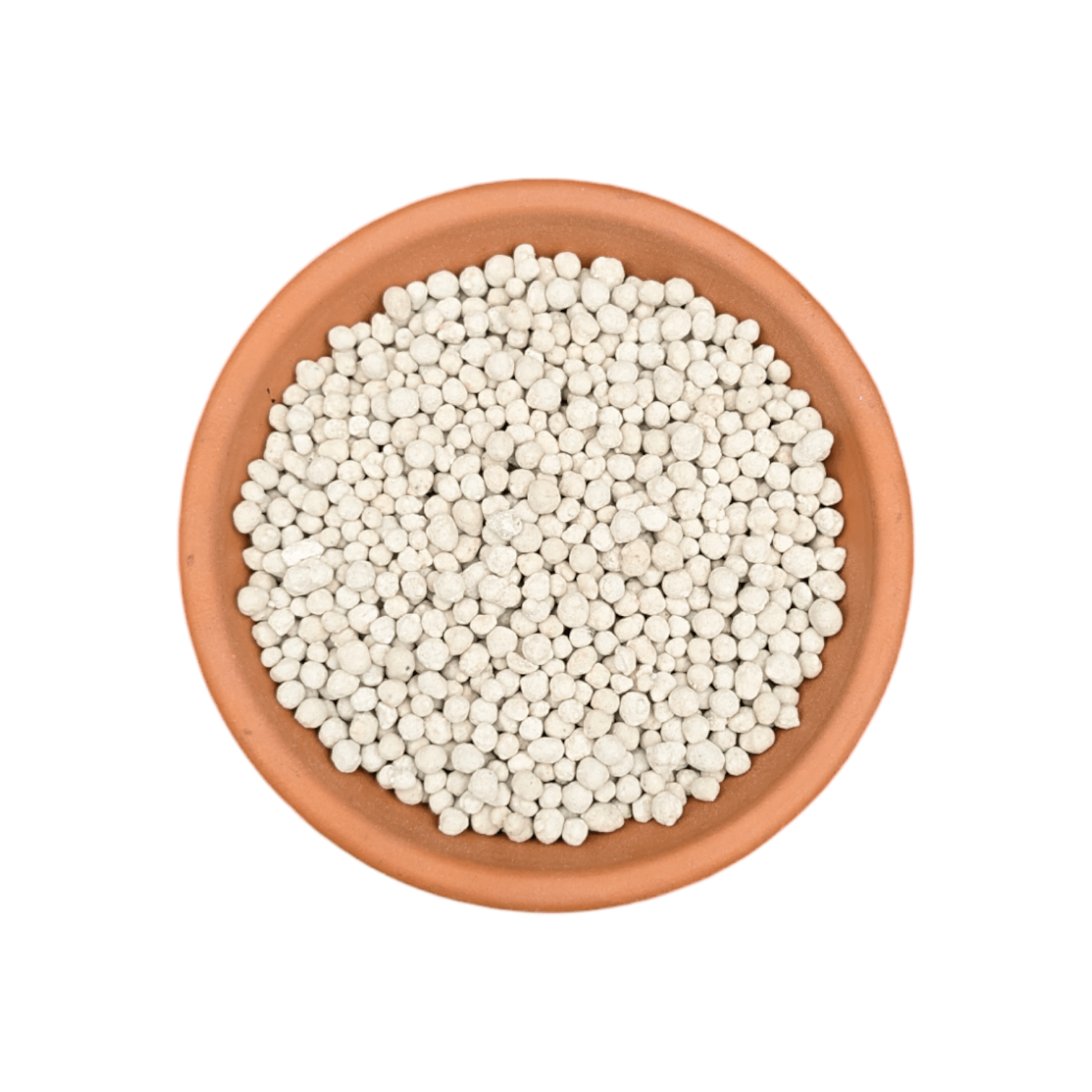Kieserite is a premium quality, naturally occurring mineral that provides essential nutrients for plant growth.
Comprised of magnesium sulphate monohydrate, it is mined from ancient marine deposits and is widely used as a fertilizer source for magnesium and sulphur in the agricultural industry.
Benefits of Kieserite:
-
Slow Dissolving: Dissolves slowly with soil moisture, providing a steady supply of nutrients over time.
-
Non-Leaching: Unlike other forms of magnesium sulphate, Kieserite will not leach quickly from the soil, ensuring a reliable and efficient nutrient supply.
-
Magnesium Boost: Supplementing magnesium increases chlorophyll production and boosts photosynthesis, enhancing overall plant health.
-
Ideal for Low-Magnesium Soils: Perfect for crops grown in low-magnesium soils, helping to improve productivity and yield.
Application Instructions:
- Suitable for soil application to a wide range of horticultural and broad acre crops.
- Not suitable for fertigation or foliar application.
- In granular form, it is ideal for blending with other granular fertilizers for custom blends.
Typical Analysis:
- 15.1% Magnesium (Mg)
- 20% Sulphur (S)
Usage Recommendations:
- Use 1 tablespoon per 30L soil as an amendment to increase magnesium and sulphur availability in your crops.
- Ideal for creating custom fertiliser blends to meet specific crop needs.
Additional Information:
Kieserite is a naturally occurring mineral that is chemically known as magnesium sulphate monohydrate. It is mined from ancient marine deposits and used in the agricultural industry as a fertilizer source for magnesium and sulphur. Kieserite is slowly water-soluble and suitable for soil application to a wide range of horticultural and broad acre crops. Kieserite is not suitable for fertigation or foliar application. In granular form, it is suited for blending with other granular fertilizers for custom blends.
FAQs:
What is Kieserite, exactly?
Kieserite is magnesium sulphate monohydrate — a naturally occurring mineral that delivers plant-available magnesium (for chlorophyll/photosynthesis) and sulphur. Ours analyses at ~15.1% Mg and ~20% S.
Is Kieserite the same as Epsom salt?
Nope. Epsom salt is the heptahydrate form (dissolves fast; great for foliar/fertigation). Kieserite is the monohydrate — slower dissolving in soil, steadier release, far less leaching. Use Kieserite for soil applications; use Epsom only if you specifically need a rapid, fully soluble Mg/S hit.
What does Kieserite fix in plants?
Classic magnesium deficiency: yellowing between the veins on older leaves (interveinal chlorosis), dull/washed-out foliage, weak photosynthesis. It also tops up sulphur for protein/enzyme function.
Who actually needs Kieserite?
Plants in low-Mg or sandy, leachy soils; crops hammered by high potassium inputs (tomato/fruit feeds can antagonise Mg); heavy feeders; container gardens with spent mixes; lawns on sandy profiles.
Can I use Kieserite in hydroponics, drip, or foliar sprays?
No. This is a soil-applied, granular product. It’s not for fertigation or foliar use.
How fast will I see results?
It starts releasing as soil moisture dissolves it. Expect a steadier response over a few weeks on existing leaves; new growth shows the clearest improvement first.
What’s the guaranteed analysis?
Approx. 15.1% Magnesium (Mg) and 20% Sulphur (S).
What’s your recommended rate?
As a soil amendment: about 1 tablespoon per 30 L of soil/mix. For beds, think light, even top-dressing in the 30–70 g/m² ballpark depending on soil tests and crop demand. Go lighter for houseplants and seedlings.
How often should I apply Kieserite?
For maintenance on established beds/fruit trees, 1–2 light applications per season is typical. For visible deficiency, correct with a single heavier pass, then switch to maintenance. Always let plant response and (ideally) a soil test tell you when to stop.
Will Kieserite change my pH?
Functionally neutral in soil. It won’t push pH around like lime or sulphur will.
Can Kieserite burn plants?
Used at sensible rates on moist soil, it’s very safe. Don’t pile it against tender stems or dump concentrated mounds. Water in after top-dressing.
Can I mix Kieserite into my own fertiliser blends?
Yes. The granular grade blends well with other granular macros/micros for custom recipes.
Any “don’t mix” rules?
Avoid combining sulphate-rich materials with calcium salts in concentrated solution (precipitation risk) — another reason we don’t recommend fertigation here. In soil blends, it’s broadly compatible.
Is Kieserite okay for organic gardens?
Kieserite is a naturally mined mineral source of Mg and S and is widely accepted in organic systems. Always check your certifier’s rules if you’re running a certified operation.
How does Kieserite compare cost-wise to Epsom salt?
Per % of magnesium delivered to the root zone, Kieserite is often the better value for soil work because less is lost to leaching and it spaces out releases. Epsom can be “cheaper per bag, pricier per result” in soils.
Will Kieserite help blossom-end rot on tomatoes?
Blossom-end rot is mainly a calcium and watering consistency issue. If Mg is actually low, Kieserite can improve overall plant health — but it won’t fix a Ca deficit or drought swings by itself.
Can I use Kieserite on citrus and fruit trees?
Absolutely. Citrus are notorious Mg hogs — apply a light ring on the dripline and water in. Repeat mid-season if foliage pales again.
What about lawns?
Great for magnesium-hungry turf on sandy soils. Think 25–50 g/m² as a light feed, followed by irrigation. Expect a deeper, more durable green versus quick-flash foliar Mg.
Is Kieserite safe for houseplants and aroids?
Yes — at tiny rates. Sprinkle a pinch on the pot surface of larger containers (5–10 g for a 30–40 cm pot), scratch in lightly, water. Repeat only if new growth still shows Mg issues.
I grow succulents/cacti — good idea or skip it?
Use sparingly. If your mix is inert/mineral and you see true Mg deficiency, a tiny top-dress followed by a thorough watering helps. Don’t overdo it.
Does Kieserite help with yellow leaves on new growth?
New leaves going yellow with green veins usually points to iron or other micronutrient issues, not Mg. Kieserite won’t fix that — diagnose first, then treat the right nutrient.
What size is the granule like?
A uniform granular grade that spreads cleanly by hand or broadcast spreader and doesn’t dust up your workspace.
Will Kieserite leach out in heavy rain?
Far less than Epsom salt. Kieserite’s monohydrate form dissolves steadily; it’s still water-soluble, but you keep more of what you apply.
How should I apply Kieserite in raised beds?
Either blend at build time (1 tbsp per 30 L of mix), or top-dress along rows, scratch in, then water. For mixed veg beds, target 30–50 g/m² unless a soil test says otherwise.
Can I stack Kieserite with composts and manures?
Yes — compost adds biology and broad nutrition; Kieserite precisely covers Mg/S without spiking NPK. That combo is exactly what living soils want.
Any situations where I shouldn’t use Kieserite?
If your soil test shows adequate or high Mg, skip it — too much Mg can tighten soil structure and antagonise calcium/potassium. Also skip it for hydro/fertigation.
What symptoms tell me Kieserite’s working?
New foliage returns to a healthy, deeper green; older leaves stop worsening; photos look crisper; and growth rate normalises.
How long should a 1 kg bag last?
Depends on area and rates. As a potting-mix amendment at 1 tbsp/30 L, one bag goes a long way; for garden beds at ~40 g/m², 1 kg covers ~25 m² as a light maintenance pass.
Storage and shelf life?
Keep it dry, sealed, and off the garage floor. It’s a mineral — stable for years if you keep moisture out.
Is Kieserite pet/kid safe?
Low toxicity, but treat like any fertiliser. Store out of reach and sweep up spills; don’t let pets inhale dust or drink runoff.
Can I use Kieserite right before planting?
Yep. Blend into the top 10–15 cm or band in the row, then water. It won’t “burn” seedling roots at reasonable rates.
Does Kieserite add sulphur smell to soil?
No. It’s a neutral-smelling mineral salt — no rotten-egg vibes.
Why doesn’t this page recommend foliar rates?
Because this product isn’t meant for foliar. If you need foliar Mg, use a fully soluble, foliar-grade magnesium product and follow that label.
Any pro tips from the DRGT team?
Don’t chase every yellow leaf with Epsom salt. Diagnose first. If your soil or media is genuinely low in Mg, Kieserite is the smarter, steadier fix for soil-grown crops — especially where rain or irrigation would just wash a quick-soluble hit away.



